 Computer game sequels are a lot like movie
sequels. Most of the time, they just aren’t as good as the original, like, say, Jaws
and Jaws II. Less often, they share certain thematic qualities, but vary so much
stylistically they almost seem different animals entirely, like Alien and Aliens. Very
rarely, a sequel not only manages to rise to the level of its original, but improves it,
continuing the story in such a way that the interplay between the narratives and
characters of the films adds depth and complexity to both of them. Films like this are
rare enough, like the Star Wars trilogy or the Godfather and Godfather II, and games like
this are even rarer. Brood War is one of these rare games. First, it continues and
improves upon Starcraft’s compelling narrative, surely one of the game’s
strongest points. It also introduces new units that mesh well into the game’s
background and general feel, but which also address play balance problems in Starcraft.
Brood War also throws in three new tilesets, an improved editor and multiplayer game, and
a great single player campaign. Starcraft is a great game; Brood War makes it even
greater. Computer game sequels are a lot like movie
sequels. Most of the time, they just aren’t as good as the original, like, say, Jaws
and Jaws II. Less often, they share certain thematic qualities, but vary so much
stylistically they almost seem different animals entirely, like Alien and Aliens. Very
rarely, a sequel not only manages to rise to the level of its original, but improves it,
continuing the story in such a way that the interplay between the narratives and
characters of the films adds depth and complexity to both of them. Films like this are
rare enough, like the Star Wars trilogy or the Godfather and Godfather II, and games like
this are even rarer. Brood War is one of these rare games. First, it continues and
improves upon Starcraft’s compelling narrative, surely one of the game’s
strongest points. It also introduces new units that mesh well into the game’s
background and general feel, but which also address play balance problems in Starcraft.
Brood War also throws in three new tilesets, an improved editor and multiplayer game, and
a great single player campaign. Starcraft is a great game; Brood War makes it even
greater. 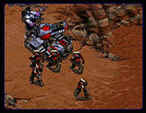 Brood War introduces seven new units to the
Starcraft universe. That may not seem like much, especially when compared to the
overwhelming amount of new units in expansion packs like Total Annihilation’s Core
Contingency, but as always Blizzard is more interested in quality than quantity. Each of
the units remedies select weaknesses in the races, resulting in much more balanced
gameplay. One reason we know the game is balanced is because so many people on the
battle.net forum keep asserting how unbalanced it is—how Protoss can always
whip Terrans or Terrans can beat Zerg. Unfortunately, just as many people will argue
exactly the opposite. One of the best things the new units do (plus some upgrades and
changes to existing units and structures) is make the rush tactic a much less effective
one. It’s a lot tougher to send a passel of zerglings or zealots out early in the
game and expect the big payoff you got previously. Brood War introduces seven new units to the
Starcraft universe. That may not seem like much, especially when compared to the
overwhelming amount of new units in expansion packs like Total Annihilation’s Core
Contingency, but as always Blizzard is more interested in quality than quantity. Each of
the units remedies select weaknesses in the races, resulting in much more balanced
gameplay. One reason we know the game is balanced is because so many people on the
battle.net forum keep asserting how unbalanced it is—how Protoss can always
whip Terrans or Terrans can beat Zerg. Unfortunately, just as many people will argue
exactly the opposite. One of the best things the new units do (plus some upgrades and
changes to existing units and structures) is make the rush tactic a much less effective
one. It’s a lot tougher to send a passel of zerglings or zealots out early in the
game and expect the big payoff you got previously.
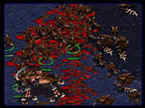 The Terran’s new units are the Medic and the Valkyrie
Missile Frigate. Medics automatically patch up wounded troops (including allies!) and can
also cast restoration, which removes troublesome spells and viruses like plague, parasite,
and even the evil ghost lockdown. While they can’t engage directly in combat, they do
have a nifty optic flare, a weapon that blinds enemy units. It’s a nice remedy for
pesky observer and detector units, and can even render siege tanks useless. The Valkyrie,
on the other hand, is the best air-to-air unit in the game. It’s heavily armored,
fires missiles in volleys of fourteen, does a lot of splash damage, and is thus absolute
hell on mutalisks. This unit takes the dreaded mutie rush out of play. Any Zerg player who
tries this tactic against a halfway intelligent Terran player is in for a very unpleasant
surprise. Another balance issue here that has nothing to do with gameplay is that both of
these units are female. It’s nice to see that some thoughtful people at Blizzard
consider women to be part of the human race’s future, dark as that future may be. The Terran’s new units are the Medic and the Valkyrie
Missile Frigate. Medics automatically patch up wounded troops (including allies!) and can
also cast restoration, which removes troublesome spells and viruses like plague, parasite,
and even the evil ghost lockdown. While they can’t engage directly in combat, they do
have a nifty optic flare, a weapon that blinds enemy units. It’s a nice remedy for
pesky observer and detector units, and can even render siege tanks useless. The Valkyrie,
on the other hand, is the best air-to-air unit in the game. It’s heavily armored,
fires missiles in volleys of fourteen, does a lot of splash damage, and is thus absolute
hell on mutalisks. This unit takes the dreaded mutie rush out of play. Any Zerg player who
tries this tactic against a halfway intelligent Terran player is in for a very unpleasant
surprise. Another balance issue here that has nothing to do with gameplay is that both of
these units are female. It’s nice to see that some thoughtful people at Blizzard
consider women to be part of the human race’s future, dark as that future may be.
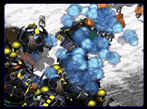 The Zerg get some great new units as well, although most will
find the Lurker to be more useful than the Devourer. The Lurker is a heavy defense warrior
mutated from hydralisks. Defenseless above ground, it wreaks havoc upon units when
burrowed, shooting waves of spines into unwary formations of enemy troops regardless of
how heavily armored they might be. It is a king-hell ground defense, and addresses the
problem that Zerg used to have once their perimeter defenses were penetrated. It’s
just a lovely, lovely unit. The Devourer fills a more specific need. It’s an flying
air-to-air unit that has a low rate of fire but packs a terrific punch. It won’t do
much against wraiths or scouts, but that’s not what it’s for. The Devourer is
specifically designed as the Zerg’s answer to the too-common Terran late game tactic
of unleashing packs of battle cruisers upon their enemies. Devourers, supported by muties,
will make short work of ‘em. The Zerg get some great new units as well, although most will
find the Lurker to be more useful than the Devourer. The Lurker is a heavy defense warrior
mutated from hydralisks. Defenseless above ground, it wreaks havoc upon units when
burrowed, shooting waves of spines into unwary formations of enemy troops regardless of
how heavily armored they might be. It is a king-hell ground defense, and addresses the
problem that Zerg used to have once their perimeter defenses were penetrated. It’s
just a lovely, lovely unit. The Devourer fills a more specific need. It’s an flying
air-to-air unit that has a low rate of fire but packs a terrific punch. It won’t do
much against wraiths or scouts, but that’s not what it’s for. The Devourer is
specifically designed as the Zerg’s answer to the too-common Terran late game tactic
of unleashing packs of battle cruisers upon their enemies. Devourers, supported by muties,
will make short work of ‘em.
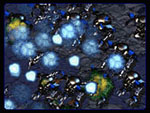 The Protoss get three new units—the Corsair medium
support fighter, the Dark Templar, and the Dark Archon. The Corsair is pretty useful;
it’s cheap, so you can build a lot of them, and in packs their neutron flares can
ravage enemy fliers. Their most impressive attribute is the disruption web. Fired from
range, it prevents enemy units on the ground or air from attacking. It’s terrific for
taking out static ground defenses, and really earns its keep when teamed with scouts or
used as part of an assault on enemy positions. The Dark Templar actually showed up as a
special unit in Starcraft; it’s a regular part of your forces now. They’re
always cloaked, are armed with deadly close combat warp blades, and give the Protoss a
sorely-needed stealth unit. They look really cool, too. Merge two of these bad boys
together and viola! you get the Dark Archon, the Protoss’ third unit and the
game’s most controversial addition. The Dark Archon has no conventional attack, but
has some powerful psychic powers, including Feedback, which drains energy from and
inflicts damage upon enemy units, and Maelstrom, which momentarily stuns organic enemy
units over a wide area. And then there’s Mind Control, which allows you to take over
enemy units and use them against their owners. In fact, you could even steal aTerran SCV
and start building your own Terran base. This caused a lot of controversy in Starcraft
forums, as it appeared to be an extremely powerful—maybe too powerful--feature. But
in practice, it’s pretty difficult to sneak up on a stray SCV, and very expensive to
build a new base—but it’s still a nasty spell. The Protoss get three new units—the Corsair medium
support fighter, the Dark Templar, and the Dark Archon. The Corsair is pretty useful;
it’s cheap, so you can build a lot of them, and in packs their neutron flares can
ravage enemy fliers. Their most impressive attribute is the disruption web. Fired from
range, it prevents enemy units on the ground or air from attacking. It’s terrific for
taking out static ground defenses, and really earns its keep when teamed with scouts or
used as part of an assault on enemy positions. The Dark Templar actually showed up as a
special unit in Starcraft; it’s a regular part of your forces now. They’re
always cloaked, are armed with deadly close combat warp blades, and give the Protoss a
sorely-needed stealth unit. They look really cool, too. Merge two of these bad boys
together and viola! you get the Dark Archon, the Protoss’ third unit and the
game’s most controversial addition. The Dark Archon has no conventional attack, but
has some powerful psychic powers, including Feedback, which drains energy from and
inflicts damage upon enemy units, and Maelstrom, which momentarily stuns organic enemy
units over a wide area. And then there’s Mind Control, which allows you to take over
enemy units and use them against their owners. In fact, you could even steal aTerran SCV
and start building your own Terran base. This caused a lot of controversy in Starcraft
forums, as it appeared to be an extremely powerful—maybe too powerful--feature. But
in practice, it’s pretty difficult to sneak up on a stray SCV, and very expensive to
build a new base—but it’s still a nasty spell.
Graphically, the game’s not much different than
Starcraft, which is a good-looking game anyway. There are three new tilesets
added—desert, snow, and twilight—and while they add some aesthetic variety to
the game, they play much like the other sets. The new units look very nice, the new
effects (especially disruption web) are very cool, and the new music is an improvement
over the original’s. The new editor looks to be updated with the new tilesets and
triggers, and loads of new SCMs should soon be flooding the web. There are no significant
changes to the interface—if it’s not broke . . .
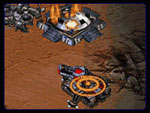 Good as all of these improvements are, the best thing about
Brood War is the single-player campaign. It picks up where the Starcraft campaign left
off, and, as the title suggests, is centered upon who (or what) will control the Zerg
broods, though there are many subplots that complicate the narrative. Most of your friends
(those that survived, that is) from the first game are here, so expect to run into Raynor
and Duke and Fenix and Mengsk and Zeratul. And you’ll see a lot of that charming
little minx Kerrigan, too. Lots of new characters get added to the mix, and lots of them
have their own little agendas. One of them, the Protoss matriarch, is yet another cool
example of the increased female presence in the Starcraft saga. Good as all of these improvements are, the best thing about
Brood War is the single-player campaign. It picks up where the Starcraft campaign left
off, and, as the title suggests, is centered upon who (or what) will control the Zerg
broods, though there are many subplots that complicate the narrative. Most of your friends
(those that survived, that is) from the first game are here, so expect to run into Raynor
and Duke and Fenix and Mengsk and Zeratul. And you’ll see a lot of that charming
little minx Kerrigan, too. Lots of new characters get added to the mix, and lots of them
have their own little agendas. One of them, the Protoss matriarch, is yet another cool
example of the increased female presence in the Starcraft saga.
There are eight Protoss, eight Terran, and
ten Zerg missions, played in that order, and they are tough missions, much tougher than
the original’s. They aren’t impossible, but it’ll take a bit of thought to
win most of them. The campaign provides lots of twists and turns, and you’ll often
wonder whom to trust, and with good reason. All of the races endure internal struggles in
the game, and each race will find itself embroiled in intra- as well as inter-racial
strife. You’ll also find some really weird alliances, as Zerg team up with Protoss,
Protoss with Terran, and Terran with Zerg. Much to Blizzard’s credit, this never
seems merely chaotic or forced. The narrative always provides a good reason for such odd
bedfellows. The voice acting and cinematics are excellent throughout, and add considerably
to the narrative’s suspension of disbelief. And though the official word from
Blizzard is that no more expansion packs are in the works, the campaign’s ending
certainly leaves plenty of room for yet another sequel.
For the legions of hardcore Starcraft fans out
there, this is a must-have. Hell, even casual Starcraft fans should pick up a copy of
Brood War. It’s a typical Blizzard game—classy, highly polished, and an
unbelievable amount of fun.
--Rick Fehrenbacher
& Al Wildey |

 Computer game sequels are a lot like movie
sequels. Most of the time, they just aren’t as good as the original, like, say, Jaws
and Jaws II. Less often, they share certain thematic qualities, but vary so much
stylistically they almost seem different animals entirely, like Alien and Aliens. Very
rarely, a sequel not only manages to rise to the level of its original, but improves it,
continuing the story in such a way that the interplay between the narratives and
characters of the films adds depth and complexity to both of them. Films like this are
rare enough, like the Star Wars trilogy or the Godfather and Godfather II, and games like
this are even rarer. Brood War is one of these rare games. First, it continues and
improves upon Starcraft’s compelling narrative, surely one of the game’s
strongest points. It also introduces new units that mesh well into the game’s
background and general feel, but which also address play balance problems in Starcraft.
Brood War also throws in three new tilesets, an improved editor and multiplayer game, and
a great single player campaign. Starcraft is a great game; Brood War makes it even
greater.
Computer game sequels are a lot like movie
sequels. Most of the time, they just aren’t as good as the original, like, say, Jaws
and Jaws II. Less often, they share certain thematic qualities, but vary so much
stylistically they almost seem different animals entirely, like Alien and Aliens. Very
rarely, a sequel not only manages to rise to the level of its original, but improves it,
continuing the story in such a way that the interplay between the narratives and
characters of the films adds depth and complexity to both of them. Films like this are
rare enough, like the Star Wars trilogy or the Godfather and Godfather II, and games like
this are even rarer. Brood War is one of these rare games. First, it continues and
improves upon Starcraft’s compelling narrative, surely one of the game’s
strongest points. It also introduces new units that mesh well into the game’s
background and general feel, but which also address play balance problems in Starcraft.
Brood War also throws in three new tilesets, an improved editor and multiplayer game, and
a great single player campaign. Starcraft is a great game; Brood War makes it even
greater.